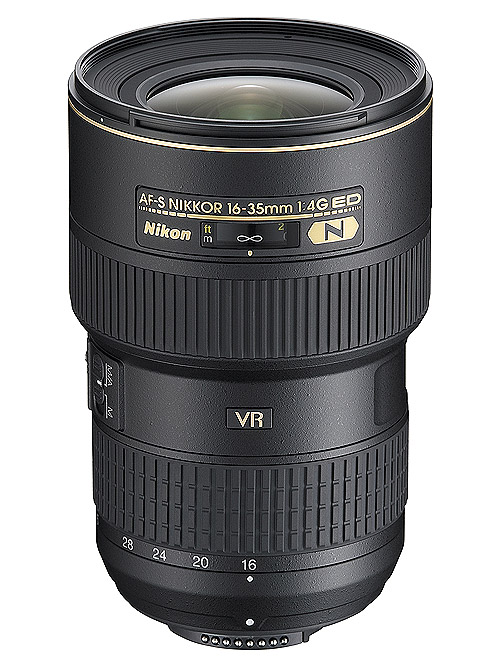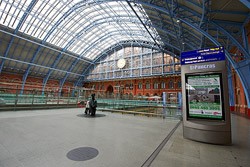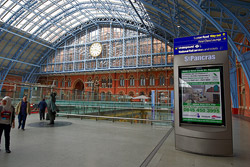Nikon AF-S 16-35mm F/4G ED VR
 |
Being the first of its kind, Nikon's new 16-35mm f/4 ultra-wide zoom, selling for £879, has garnered quite a lot of interest, especially from those who wish to use filters for landscape work, as Nikon's current top-line ultra-wide, the 14-24mm F/2.8 can't accept filters. Nikon users have been crying out for lenses like this to rival Canon's range of f/4 aperture professional lenses for ages. Here we'll take a close look at how it performs.
This particular optic costs around £880 has a constant aperture of f/4, Nano-Crystal coatings to help reduce ghosting and flare and Vibration Reduction, which Nikon claim will allows sharp shots to be achieved at shutter speeds up to 4 stops slower than without. This lens can be used with Nikon's FX or DX sensor cameras. On a DX camera the lens will provide an angle of view equivalent to that of a 24-52.5mm lens on a full-frame camera.
Nikon AF-S 16-35mm F/4G ED VR: Handling and features
Typical of Nikon's professional grade lenses, the build quality is very good, but in this case the lens isn't overly large or heavy. At 125mm long, it's only a bit larger than Nikon's diminutive, but rather old 20-35mm f/2.8 and the weight of 685g makes it balance extremely well on my Nikon D700 with or without the optional MB-D10 grip.
High quality plastics have been employed for most of the construction which have a textured finish that shouldn't show marks easily. The lens accepts 77mm filters on the front of the lens, which will please a lot of photographers interested in shooting landscapes. The filter thread is plastic but I didn't have any issues with metal filters cross-threading during use. A petal shaped hood and soft lens case are provided in the box.
Zooming is controlled by the wide rubber grip closest to the camera body. There is plenty of resistance to ensure zoom creep isn't an issue and although the mechanism seems quite smooth on this sample, zooming the lens in and out makes quite an audible hollow noise. I didn't find this too disturbing in use though.
The lens doesn't extend during focus or zooming as the front element moves back and forth inside the lens body. I found autofocus to be very quick, accurate and virtually silent thanks to Nikon Silent Wave focusing motor. Manual focus adjustments can be made at any time, but this is a feature I would rarely use on a lens as wide as this.
Nikon AF-S 16-35mm F/4G ED VR: Performance
For this review, the lens was tested on a 12Mp Nikon D700 using Imatest.
Throughout the zoom range, this lens is capable of good to excellent resolution across the frame. Wide open at 16mm the lens performs very well in the centre with the corners being slightly less sharp, but still very good. Peak performance at 16mm is achieved at f/5.6, where the resolution is approaching excellent across the frame. This lens seems to suffer with softening due to diffraction a little more than similar lenses I've tested, with the resolution steadily dropping off as the lens is stopped down after f/5.6 although it is still performs well enough at f/16. f/22 shows a marked loss of contrast and resolution compared to other apertures.
At 24mm, the lens appears to be at its best, with excellent resolution being recorded between f/4 and f/8. Still the lens suffers in the same way as at 16mm with diffraction but is still good down to f/16.
By 35mm, the resolution drops off a little, especially towards the edges of the frame. At f/4, the sharpness in the centre of the image is very good, but edges of the frame are a fair bit softer. The quality towards the edges of the frame gradually improves as the lens is stopped down and peak quality across the frame is achieved between f/8 and f/11.
Colour aberrations are kept in check well by this optic. They are at their highest levels at 16mm and f/4, where fringing can cover up to 0.6 pixel widths. This will rarely be noticeable, even upon close inspection. As the lens is zoomed in, the levels of CA fall to very low levels indeed.
At 16mm and f/4, light falloff towards the corners of the image is quite pronounced. Here the corners are 2.2stops darker than the image centre, and the lens needs to be stopped all the way down to f/8 for visibly even illumination. At 35mm this optic fairs better as the corners of the image are only 1.24 stops darker than the centre at f/4. Stopping down to f/5.6 provides visibly even illumination.
Distortion at 16mm is quite pronounced and may cause issues to those requiring straight lines in their images. Imatest recorded barrel distortion of 7.57% at 16mm, luckily the distortion pattern is uniform, so it should be quite easy to correct in image editing software afterwards. By 35mm, distortion is controlled much better. Imatest recorded 0.6% pincushion here, which should pose few issues in normal use.
As with other lenses Nikon's Nano Crystal coating do a very good job of keeping flare to a minimum. Strong point sources of light in the frame may cause a little flare in extreme circumstances, but flare will not be an issue most of the time. Strong light sources just outside of the frame may cause a slight drop in contrast, but again this will only pose issues in extreme circumstances.
The VR system fitted to this lens promises to allow handheld photography at shutter speeds up to 4 stops slower than would be possible with the system switched off. At 16mm, I managed sharp shots about 3 times out of 4 at a quarter of a second, which is about two stops slower than the focal length should allow and the same consistency at an eighth of a second at 35mm. Even if I couldn't achieve the advertised four stops, such a slow shutter speed should make this lens suitable for photographing static subjects in very low light conditions without a support, which may come in handy for travel.
Nikon AF-S 16-35mm F/4G ED VR: Verdict
Overall this lens is a very good all round performer being capable of producing images of very good resolution, especially in the centre of the frame where the performance is excellent up to 24mm and very good thereafter. The performance in this respect isn't as stunning as the 14-24mm lens as I'd hoped, but is still very respectable indeed.
This lens' weaknesses are falloff and distortion. Distortion at 16mm is actually slightly stronger than I found on Nikon's 14-24mm at 14mm, which surprised me. If you can live with these foibles I wouldn't let this put you off this optic.
With this lens being able to accept filters, this lens should find a home in many Nikon-shooting landscape photographer's kit bags and the VR feature may open possibilities for those who wish to stop down for depth of field or take pictures in low light without a support.
This is the lens many Nikon shooters have been waiting for, and although it doesn't amaze me like the 14-24mm did, it is still a very capable professional quality lens.
Nikon AF-S 16-35mm F/4G ED VR: Pros
 Good all-round resolution performance
Good all-round resolution performance Lighter than f/2.8 lenses
Lighter than f/2.8 lenses Accepts 77mm filters
Accepts 77mm filters Vibration Reduction
Vibration ReductionNikon AF-S 16-35mm F/4G ED VR: Cons
 Barrel distortion at 16mm
Barrel distortion at 16mm Vignetting at 16mm
Vignetting at 16mm
| FEATURES |  |
| HANDLING |  |
| PERFORMANCE |  |
| VALUE |  |
| OVERALL |  |
PRODUCT NAME: Lens specification
| Price | £879 |
| Contact | www.nikon.co.uk |
| Filter size | 77mm |
| Format | Full-frame |
| Construction | 17 elements in 12 groups |
| Angle-of-view | 107° - 63° |
| 35mm equivalent focal length (on APS-C body) | 24-52.5mm |
| Internal focusing | Yes |
| Image stabilisation | Yes |
| Minimum focus | 0.28cm |
| Maximum aperture | F/4 |
| Minimum aperture | F/22 |
| Weight | 685g |
| Size | 125x82.5mm |
| In the box | Lens Hood, Soft Case |
The Nikon AF-S 16-35mm F/4G ED VR costs around £879 and is available from Warehouse Express here:
GREAT Lens for FX - Get the 16-85mm VR instead for DX
I knew the moment I heard about this lens that I'd need to get one. The chief problem I have with every other FX/film-sized wide angle lens is that they are either immense, heavy and extremely expensive; or quite mediocre* and not as wide as I'd like (and a few lens-generations old by now, as well). I had no doubt, given the excellence of nearly every recent Nikon lens, that it would be superb in terms of color, sharpness and focus performance - and only really wondered, before I'd seen it in person, whether its size would be appropriate for my use as a casual amateur photographer.
It is, almost, perfect.
More Detail : http://webcamerawebcamera.com/detail.php?id_detail=Nikon-16-35mm-f-4G-EDVR-II-AF-S-IF-SWM-Nikkor-WideAngle-Zoom-Lens-for-Nikon-Digital-SLR-Cameras&template=4
I knew the moment I heard about this lens that I'd need to get one. The chief problem I have with every other FX/film-sized wide angle lens is that they are either immense, heavy and extremely expensive; or quite mediocre* and not as wide as I'd like (and a few lens-generations old by now, as well). I had no doubt, given the excellence of nearly every recent Nikon lens, that it would be superb in terms of color, sharpness and focus performance - and only really wondered, before I'd seen it in person, whether its size would be appropriate for my use as a casual amateur photographer.
It is, almost, perfect.
More Detail : http://webcamerawebcamera.com/detail.php?id_detail=Nikon-16-35mm-f-4G-EDVR-II-AF-S-IF-SWM-Nikkor-WideAngle-Zoom-Lens-for-Nikon-Digital-SLR-Cameras&template=4
Add your message
Login required
Please login here or if you've not registered, you can register here. Registering is safe, quick and free.
Please login here or if you've not registered, you can register here. Registering is safe, quick and free.
photodo Stats
1102 lenses
428 MTF tests
74 in-depth photodo reviews
100+ users join each day
Help the lens community by reviewing or rating a lens today via our lens search
428 MTF tests
74 in-depth photodo reviews
100+ users join each day
Help the lens community by reviewing or rating a lens today via our lens search
Latest Lens Reviews
- Chinon 28mm f/2.8 Vintage Lens Review
- Canon EF 70-200mm f/4L IS II USM Lens Review
- Samyang AF 85mm f/1.4 EF Review
- Sigma 70mm f/2.8 DG Macro Art Review
- Samyang AF 24mm f/2.8 FE Review
- Meike 50mm f/1.7 Review
- Tamron 70-210mm f/4 Di VC USD Review
- Lensbaby Burnside 35mm f/2.8 Review
- Asahi Super Takumar 50mm f/1.4 Review
- Asahi Super-Multi-Coated Takumar 135mm f/3.5 Review








